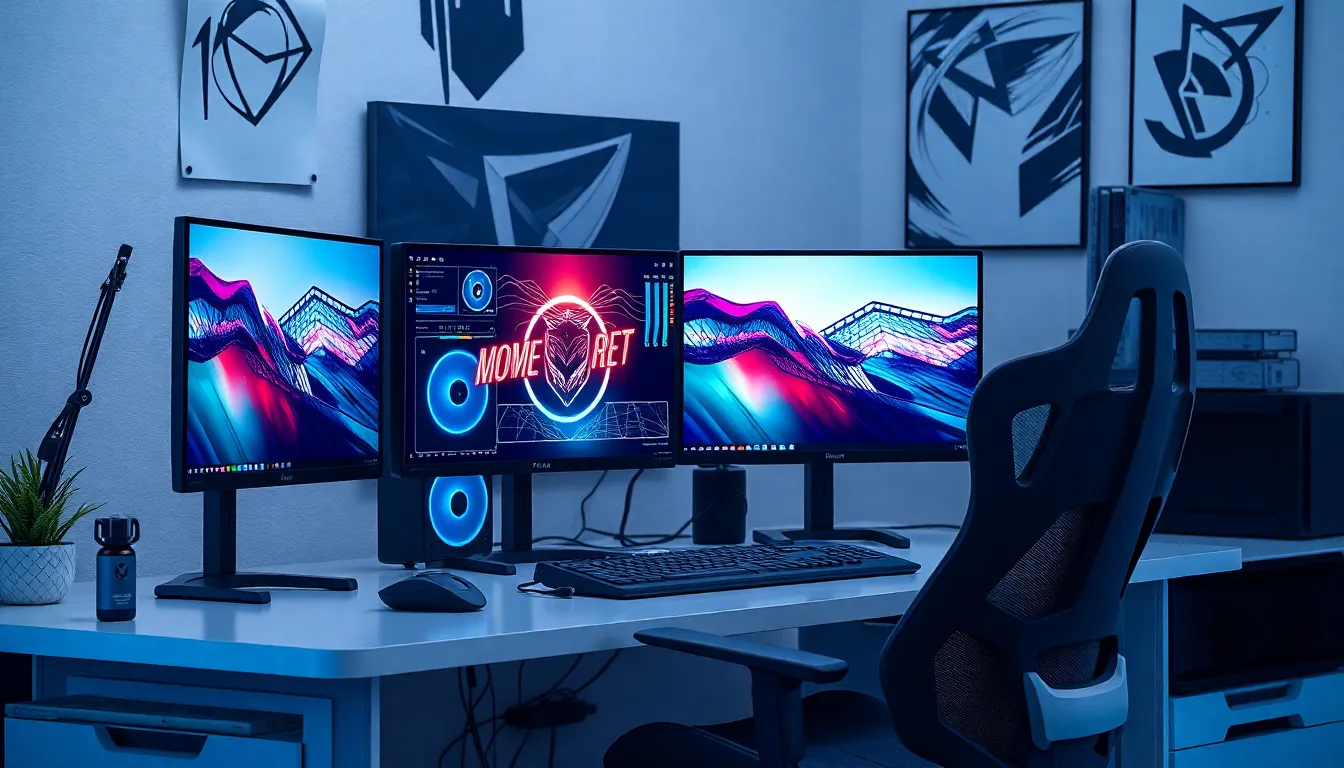Table of Contents
ToggleIn today’s fast-paced digital world, desktop workstations have become essential tools for professionals across various fields. These powerful machines are designed to handle demanding tasks, from graphic design to data analysis, providing the performance and reliability users need to excel. With advancements in technology, desktop workstations now offer enhanced processing power, superior graphics capabilities, and increased storage options, making them a top choice for businesses and creatives alike.
Investing in the right desktop workstation can significantly boost productivity and efficiency. Whether it’s for a bustling office environment or a home setup, understanding the features and benefits of these systems is crucial. This article explores the key elements of desktop workstations, helping users make informed decisions tailored to their specific needs.
Overview Of Desktop Workstations
Desktop workstations serve as powerful computing solutions designed for high-performance tasks. These machines typically feature robust hardware configurations, including multi-core processors, high-end graphics cards, and extensive RAM. This design makes desktop workstations suitable for demanding applications in graphic design, engineering, and data analysis.
Desktop workstations encompass various configurations tailored to specific professional requirements. Here are key components commonly found in these systems:
- Processors: Many desktop workstations utilize Intel Xeon or AMD Ryzen processor families, offering superior performance and multitasking capabilities.
- Graphics Cards: Numerous models, such as NVIDIA Quadro or AMD Radeon Pro, provide advanced graphics performance, essential for rendering and simulation tasks.
- Memory: Many configurations support 16 GB to 128 GB of RAM, allowing users to run multiple applications without performance degradation.
- Storage: Diverse storage solutions integrate SSDs and HDDs, optimizing speed and capacity for large files and complex applications.
- Cooling Systems: Enhanced cooling mechanisms ensure stability during intensive workloads, preventing overheating and system failures.
Desktop workstations also emphasize expandability, allowing users to upgrade components as technology evolves. They often incorporate multiple PCIe slots and ample storage bays, accommodating increased processing demands as workflows change.
Selecting the optimal desktop workstation hinges on understanding specific professional needs, whether for 3D modeling, software development, or video editing. The right workstation significantly boosts productivity and efficiency by providing tailored solutions designed to meet various operational challenges.
Many manufacturers, such as Dell, HP, and Lenovo, offer a range of desktop workstations, each equipped with unique features catering to different user preferences and usage scenarios.
Key Features To Consider

Selecting a desktop workstation involves evaluating several critical features that directly impact performance and user experience. Key aspects to focus on include performance specifications and design ergonomics.
Performance Specifications
Performance specifications dictate how effectively a workstation handles demanding tasks. Consider the following components:
- Processors: Options typically include Intel Xeon or AMD Ryzen processors, ensuring robust performance for multitasking and heavy applications.
- Graphics Cards: High-performance graphics cards like NVIDIA Quadro or AMD Radeon Pro are essential for graphic-intensive tasks, enabling smooth rendering and visualization.
- Memory: Workstations commonly range from 16 GB to 128 GB of RAM, affecting multitasking capabilities and overall responsiveness.
- Storage Solutions: SSDs offer faster read/write speeds compared to traditional HDDs, enhancing load times and data retrieval.
- Cooling Systems: Effective cooling mechanisms prevent overheating during prolonged use, contributing to optimal system performance.
Design and Ergonomics
Design and ergonomics play a vital role in workstation comfort and productivity. Important design aspects include:
- Form Factor: Desktop workstations can vary in size and layout, suitable for different office environments and user preferences.
- Ease of Access: Tool-less designs for replacing components simplify maintenance and upgrades, facilitating a quicker turnaround.
- Cable Management: Well-organized cable routing enhances workspace aesthetics and reduces clutter, promoting a more efficient work environment.
- Adjustability: Ergonomic features such as adjustable monitor stands or docking stations improve posture and reduce physical strain during extended use.
These features combined create a workstation that not only performs well but also supports long-term user comfort and satisfaction.
Popular Desktop Workstations
Desktop workstations cater to diverse professional needs, ranging from high-end solutions for demanding tasks to budget-friendly options for basic functions. Below are notable categories within this segment.
High-End Options
High-end desktop workstations excel in performance and customization. They often feature Intel Xeon processors or AMD Ryzen Threadripper models, delivering superior computing power for resource-intensive applications. Graphics capabilities utilize top-tier GPUs such as NVIDIA Quadro or AMD Radeon Pro, supporting complex rendering and simulations.
| Model | Processor Type | Graphics Card | RAM Options | Price Range |
|---|---|---|---|---|
| Dell Precision 7920 | Intel Xeon | NVIDIA Quadro RTX 8000 | Up to 512 GB | $4,000 – $7,000 |
| HP Z8 G4 | Intel Xeon | AMD Radeon Pro WX 8200 | Up to 256 GB | $3,500 – $6,500 |
| Lenovo ThinkStation P920 | Intel Xeon | NVIDIA Quadro RTX 6000 | Up to 512 GB | $4,000 – $8,000 |
Budget-Friendly Choices
Budget-friendly desktop workstations manage efficiency and affordability without sacrificing core functionalities. These workstations typically come with Intel Core i5 or AMD Ryzen 5 processors, ideal for tasks like document processing and light graphic design. Users can expect decent performance with integrated graphics or entry-level dedicated cards.
| Model | Processor Type | Graphics Card | RAM Options | Price Range |
|---|---|---|---|---|
| Dell OptiPlex 7080 | Intel Core i5 | Integrated Graphics | Up to 32 GB | $800 – $1,500 |
| HP ProDesk 400 G6 | Intel Core i5 | AMD Radeon RX 530 | Up to 16 GB | $700 – $1,200 |
| Lenovo ThinkCentre M720q | Intel Core i5 | Integrated Graphics | Up to 32 GB | $600 – $1,100 |
Comparisons With Laptops
Desktop workstations and laptops serve different purposes, with each having distinct advantages depending on user needs. Desktop workstations excel in performance and expandability, while laptops prioritize portability and convenience.
| Feature | Desktop Workstations | Laptops |
|---|---|---|
| Performance | High processing power, ideal for heavy tasks | Moderate performance, suitable for general use |
| Graphics Capability | Enhanced graphics support with powerful GPUs | Integrated graphics for basic tasks |
| Upgradability | Easily upgrade components like RAM and storage | Limited upgradability; upgrades often require special parts |
| Ergonomics | Designed for comfort during long usage | Compact, sometimes leading to discomfort over extended periods |
| Portability | Stationary with no built-in battery | Highly portable with built-in batteries |
Desktop workstations provide superior processing capabilities, with configurations featuring multi-core processors and dedicated graphics cards, essential for tasks like graphic design and data analysis. Laptops, while versatile, often utilize lower-end processors that limit their performance in resource-heavy applications.
Users seeking a customizable setup will find desktop workstations advantageous due to their modular design. They allow users to easily swap out components such as graphics cards or add additional storage, catering to evolving demands. Laptops, by contrast, typically offer fewer options for customization, focusing on integrated solutions that maximize mobility over raw power.
For professionals who need powerful machines for tasks like 3D modeling, large-scale data analysis, or video editing, desktop workstations are the more reliable choice. Laptops favor those who require flexibility and portability, ideal for remote work or frequent travel.
Future Trends In Desktop Workstations
Desktop workstations are evolving rapidly, driven by technological advancements and changing user demands. Notable trends shaping their future include increased reliance on artificial intelligence (AI), enhanced connectivity options, and a focus on sustainability.
- Artificial Intelligence Integration: Workstations increasingly incorporate AI-driven applications that optimize performance. Tasks like data analysis and graphic rendering benefit from machine learning techniques, improving speed and accuracy.
- Remote Work Capabilities: The rise of remote work prompts manufacturers to enhance desktop workstations with cloud computing compatibility. Users can access powerful applications from anywhere, allowing for flexibility in work environments.
- Modular Designs: Modular workstations emerge as a trend, allowing users to customize and upgrade components easily. This adaptability extends the workstation’s lifespan and accommodates evolving professional needs.
- High-Performance Graphics: Advances in graphics processing units (GPUs) occur consistently, enabling support for 8K resolution and virtual reality (VR) applications. Designers and engineers leverage these capabilities for more immersive experiences and refined visuals.
- Eco-Friendly Solutions: Sustainability efforts are shaping manufacturing processes. Companies focus on using recyclable materials and energy-efficient components, appealing to environmentally conscious users.
- Enhanced Security Features: Cybersecurity measures gain importance due to increasing remote access. Workstations now incorporate advanced security protocols, including biometric authentication and hardware-based security.
- Improved Ergonomics: Ergonomic designs prioritize user comfort and productivity. Features like adjustable stands and better cable management enhance the overall workstation experience.
These trends reflect the growing complexity of professional workloads, driving the demand for powerful and efficient desktop workstations tailored to meet diverse professional needs.
Desktop workstations are crucial for professionals seeking high performance and efficiency in their work. With advancements in technology and a variety of options available, users can find solutions tailored to their specific needs. Whether opting for high-end models or budget-friendly choices, the right workstation can significantly enhance productivity.
As the landscape of work continues to evolve, staying informed about emerging trends and features will ensure that users make the best decisions for their computing requirements. Investing in a powerful desktop workstation not only meets current demands but also prepares users for future challenges in their respective fields.




